|
YELLOWER
|
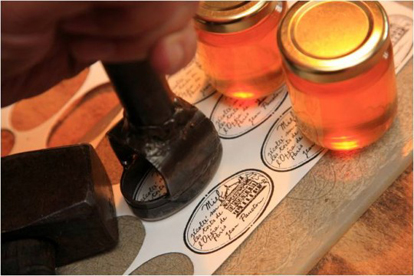
|
|
photo by eric tourneret
|
Is it me or is it happening?
Of course, I was just following a hunch when saying that yellow would be the new pink, yet I do seem to see more and more yellow in detail as well as in bigger pieces of fashion and design – even as a colour for scooters and cars. Yellow seems to resonate with today’s current mentality, searching for a break from pessimism, radiating confidence and glowing health and wealth.
As discussed last week, the arrival of mustard is changing our taste palette and style palette all at the same time; distributing tanginess in our salads, soups and sauces and a range of strange warm colours from light brown to bright yellow to yellow-green. This week I would like to discuss honey, which also seems to be an important ingredient on its way to becoming a mega trend. With the current bee scare (where we see bees endangered and disappearing at an alarming scale), it is only natural that honey becomes a luxury too.
With our countryside monopolised by industrial farming, biodiversity is in danger, causing beehives to die and bee colonies to dwindle. The cynical truth engrained in the condemning of an instrument of our own survival is telling of the power of greed over the basic intelligent management of our planet. Without bees no food, without food no survival; thus we are toying with the livelihood of our species just by dedicating land to the feeding of poor animals, destined to be industrialised for the mass consumption of tasteless hamburgers.
Therefore it is sort of a relief to know that bees are swarming to join us in the world’s big cities since bee biodiversity is now greater within the urban context – a strange reversal of fortune where our bees feed in our parks, rooftops, balconies and urban gardens, accessing plants, flowers and herbs from the four corners of the world as accumulated by us modern nomads. These urban bees are very happy to transform their exotic finds into fusions for new kinds of honey.
Thus the beehives atop the luxury brand buildings and major world bank edifices are doing well enough to presume that we will soon see Vuitton Honey and Hermès Royal Jelly from their own farms. Bringing us different honey colours to be used also as the nicest colourcards for their leather goods and scarves.
Biodiversity beauty!
To be continued…
Lidewij Edelkoort
|
|
|
|
|
TOOLS & STANDARDS
|
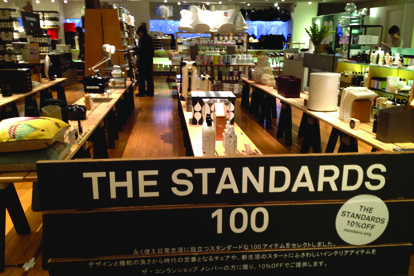
|
|
photo by kaori Leyasu
|
|
Sometimes we find a similar keyword around us at the same time, different approaches but with the same meaning.Then we start to think about it as it can be the seed of a new trend.
Recently I found two different events and two special stories in magazines about the same topic: tools and standards
First, a pop-up shop called “Tools” opened in Daikanyama. A small gallery totally transformed for the occasion with tools from England, France, USA and Japan. It's quite ordinary things, more traditional than new but, surprisingly the gallery was full of people with sparkling eyes, as blown away as if they see something totally new and amazing !
Another exhibition was held, in the Conran shop in Shinjuku, called "The standards 100” presenting a selection of 100 common and timeless pieces, from furniture to soap and kitchen tools.
Then I open the fashion magazine Ginza and read the article “ searching for our standards”, about basics shirts, pants, shoes and so on. This magazine is know to be influential and vanguard, specialized in introducing new trends,designers and looks.And, finally, in the Casa Brutus, the main topic was “ good tools which we want to use for long”.
So I start wondering why we are tempted with tools and standards. I came to this reflexions: maybe it's because we're living in an immaterial world for a while, communicating and living more on internet than in real life, in fast fashion, fast marketing for years, so we want to have a real relationship with things, keep them and feel their unchanged charms.
Maybe because we start to feel suspicious about “designed” things, surrounded by fast and nonsense design (“designers apartment”, “designers hotel”, “designers food”) which we cannot find any “design philosophy” behind. So we started to wonder what is the real meaning of design.
Then we slowly look for the basics and classic things which have survived over centuries, and we still use in our daily life. We turn the page of tailoring skill to know what the suits are made of.
This must be some reasons to explain the return of “tools and standards”.
Kaori Leyasu
|
|
|
|
|
FRAGRANCE OF THE FUTURE
|
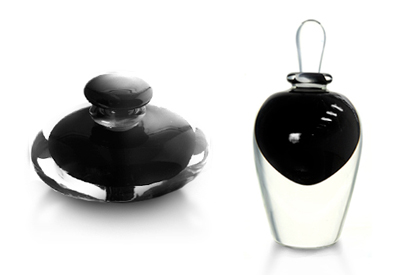
|
|
photo by frazer parfum
|
|
Frazer Parfum is a small perfume house based in Cape Town. Frazer Parfum's philosophy and perfumes are one of a kind, addressing major and hearted upcoming wishes of the consumer for meaningful concepts, rural products, handcrafted items, ethic considerations, everyday luxury and beauty.
Tammy Frazer as head of the house personally creates all perfumes by hand. As a perfumer Tammy works only with natural and organic raw materials sourced on quality by herself directly from the farmers around the world. Her ready to wear collection is called Chapters and is inspired by Tammy's expeditions travelling to the source of the raw materials, meeting the farmers and discerning their methods of farming, harvesting and distillation.
In 1953 Tammy's grandfather, chemist and inventor Graham Wulff, created the world's leading beauty fluid Oil of Olay. Fast forward to Tammy's father while she was growing up, he worked at Swiss perfume powerhouse Givaudan while both her aunt and uncle, as chemists, pioneered the start of Homeopathy in South Africa.
Frazer Parfum actively operates under the basis of a harmonious and just development by educating local industry in the art of perfumery by activating a traditional industrial sector to participate in the economic revival of essential oil farmers in South Africa.
Seeking out opportunity to positively change attitudes within South Africa by influencing others to be like-mindedly conscious with daily attention to hold respect for others and for the environment as well as the incessant research for quality is incarnated in Frazer Parfum.
Sophie Carlier
www.frazerparfum.com
|
|
|
|
|
IMPROVING EDUCATION THROUGH DESIGNED ARCHITECTURE
|
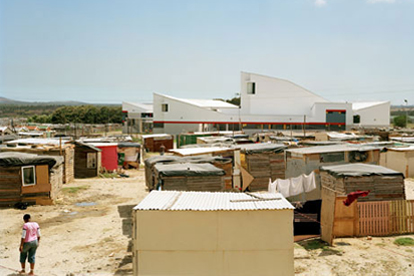
|
|
photo by nor and wolf
|
|
As recently seen at the design conference Design Indaba held in Cape Town this March 2012, South African architect Heinrich Wolff proves that the level of education can be improved by the attention spent designing school buildings.
At the Inkwenkwesi school in a Western Cape township, teachers were wasting their time chasing students to come to class instead of instructing them, so the architects remodeled the recess areas in an undulating shape to provide supervision at a glance.
Noero and Wolff also shape roof openings to filter light at an angle to block direct sun in the summer, and let it in in winter to warm the floors; this natural AC and heating process provides at no energy costs a temperate climate within the building that allows for well-being hence better concentration when used in a school.
After reconstruction, the graduation passing rate of Inkwenkwesi school went from 30% to 82%. This is an example of how the process of design can improve education and neighborhood life in socially challenged areas of the planet.
Emmanuelle Linard
www.noerowolff.com
|
|
|
|
|
"CAFE COUTURE"
|
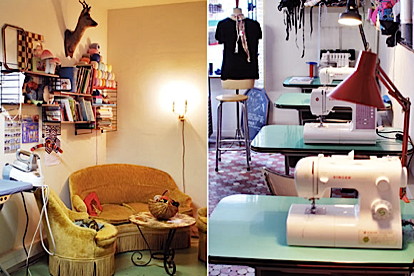
|
|
photo by café couture
|
|
The phenomenon of “Do It Yourself” is entering our society more and faster. A major problem many of us are facing is the lack of equipments to make things ourselves. "Sweat shop" is a mixture between a cafe and an atelier: a new creative concept situated near hotspot canal St Martin in Paris, a place where Parisian bo-bos (bourgeois bohemia) can do things themselves.
People are welcome to join, to experience and to trigger to make to most creative and personal creations.The place rents sewing machines and knitting machines.
To reach a larger audience then just those who know how to create and realize ideas, workshops are offered to learn how to customize and to imagine creative ideas.
Sewing and knitting are only two examples of the many possibilities this trend offers. In times of crisis and lack of money we feel driven to fix things ourselves. Specialized professions take place for more all-rounders. Fixing your own washing machine, cutting the hair of your friends, creating a personal wardrobe, gaining knowledge of haute cuisine ... A tardy and conscious lifestyle has become modern. We all feel the pressure to save money and this triggers us to understand more of our daily life and issues. We invest money in courses to become talented or at least advanced in tasks we don’t know about.
Willem Schenk
www.sweatshopparis.com
|
|
|
|
|
EXHIBITION
|
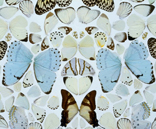
|
Damien Hirst
Damien Hirst first came to public attention in London in 1988 when he conceived and curated "Freeze", an exhibition in a disused warehouse which showed his work and that of his friends. This is the first substantial survey of his work in a British institution and brings together key works from over twenty years. Until 9 September 2012 in Tate Modern London.
More
|
|
|
BOOK
|
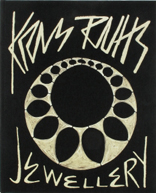
|
|
Kris Ruhs - Jewellry
Kris Ruhs has over the years built up a sizable body of work, each piece hammered, shaped and composed in a way that echoes the artist's creation of his larger sculptures. Ruhs artistic curiosity is reflected in mediums as diverse as rope, wood, silver, brass and gold. The organic elements individually fashioned in these materials, when joined together, lead the eye into seeing increasingly complex relationships. Between the simple shapes he chooses to fashion. The catalogue collects Ruhs' projects from his first exhibitions in New York City in the 1980's into the present.
Shop
|
|
|
EXHIBITION
|
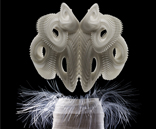
|
Iris van Herpen
Until 23 September 2012, the Groninger Museum, located in the north of the Netherlands, presents the first large-scale solo exhibition of the work of Iris van Herpen, one of the most striking designers of this moment. The exhibition offers an overview of her work from 2008 to the present.
More
|
|
|
MORE TRENDS
|
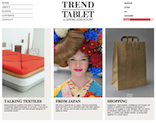
|
TREND TABLET
trendtablet.com explains how trends grow, evolve and flow, and helps us better understand and perceive how they interact in our daily lives.
this tool accessed for free is open to comments and new ideas, please contribute and be part of our network .Enjoy!
More
|
|
|
JOIN US
|
|
|
|
BOOK
|
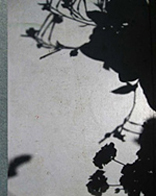
|
|
Collier Schorr - Blumen
Collier Schorr has been working in Southern Germany for the past 13 years, compiling a documentary and fictional portrait of a small town inhabited by historical apparitions. Blumen is the second volume of Forest and Fields and moves away from the figure. Schorr decided instead to look for or build arrangements in the landscapes and domestic and commercial settings of her much investigated town. Flowers are uprooted so as to become performers in the landscape; signage, plums, chairs and a plaster fawn are some of the shapes of things moved and combined to further detail the daily life of the townspeople of Schwabish Gmund.
Shop
|
|
|
MAGAZINE
|
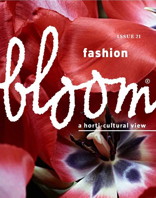
|
Bloom
Over the last few seasons we have seen flowers starting to bloom on textiles, experimental plants invading dresses and witnessed leaves whirling onto scarves.Therefore, we have created a magazine that is much like a bazaar, containing all the types of fashion that flowers have to offer, exploring their influences to the fullest.
Shop
|
|
|
|
CATALOGUE
|
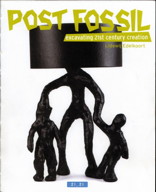
|
Post Fossil
Post Fossil. Excavating 21st century creation. This catalogue was printed on the occasion of the exhibition in Tokyo.
Shop
|
|
|
